 |
||
|
||
| ||
Acer Labs was first to get the license for production of chipsets for the Intel's Pentium 4. However, some other companies which got their licenses later and which don't still get such have already released their own samples of chipsets. But after the SiS 645 it is absurd to launch a product supporting DDR266 at best. That is why when we got the ALi Reference Board on so long awaited ALADDiN-P4 we weren't surprised that the chipset supported both DDR333 and UltraATA/133. ALi ALADDiN-P4 chipset The ALi M1535D+ south bridge is standard for desktop products based on the Acer Labs chipsets (see our reviews on ALi MAGiK 1 and ALi ALADDiN Pro5T). The only difference is the UATA/133 support. I'm glad that the company didn't puff up this change and left the old marking. 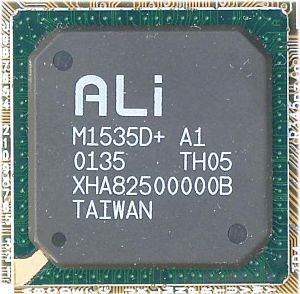 The M1671 north bridge is the most interesting in the ALi ALADDiN-P4 as this is the first solution from Acer Labs for the Pentium 4 platform. Here are its characteristics:
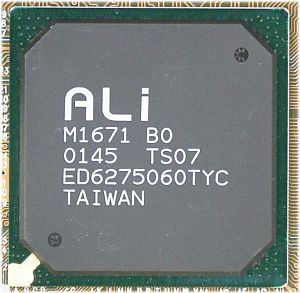 On the one hand, the chipset supports UATA/133 and DDR333 AKA PC2700; on the other hand - it is linked with the south bridge with the an PCI bus. But I understand why ALi doesn't want to give up the M1535D+ - it has spent so much time to debug it. ALi ALADDiN-P4 based AP715D3S Reference Board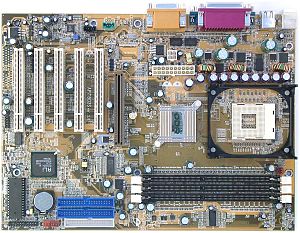 The layout of the board is elaborate, it has 5 PCI slots (hint at AMR/CNR) and space for a rectangular chip of quite a big size (probably PCI sound). The power supply unit must comply with the ATX 2.03 standard (so called "Pentium 4 Compatible"). It doesn't makes much sense to pay attention to the BIOS as you will never see such settings in any production boards. Unfortunately, we were not able to check operation of the DDR333 on this board as the current version of the Reference Board doesn't allow setting simultaneously FSB 100 MHz and DDR SDRAM 166 MHz. That is why we tested the ALi ALADDiN-P4 chipset only in combination with PC2100 (DDR266). Test system configurationTestbed:
Software
TestsFirst of all we will show you the diagrams where the chipsets perform almost equally:
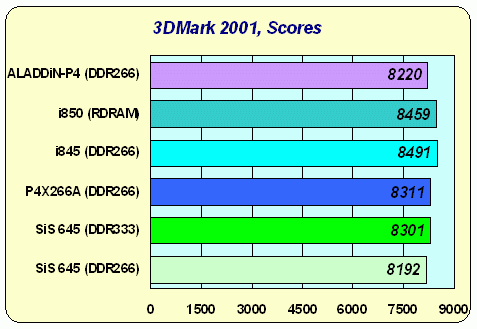
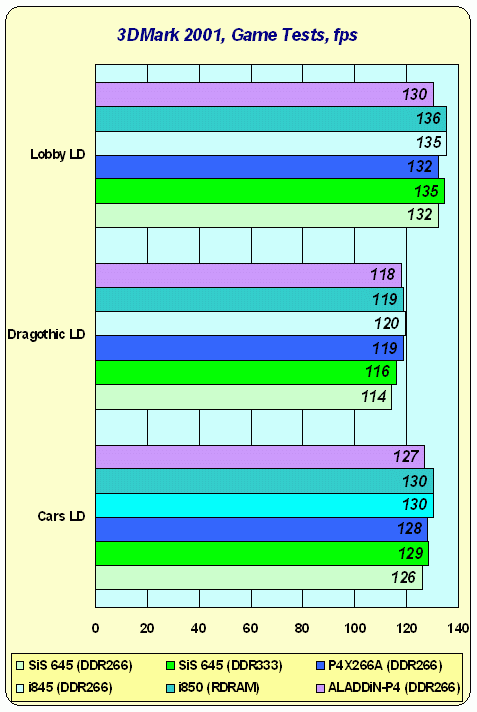
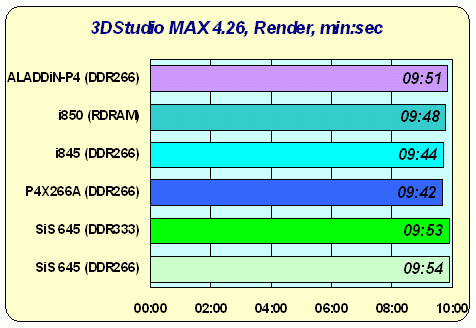

Gaming applications


In the Quake III all chipsets fall into two categories: champions (i850 and VIA P4X266A) and the rest - both SiS 645s, i845DDR and ALi ALADDiN-P4. In the Expendable the P4X266A falls behind, and the i850 remains a single leader. The synchronous architecture and the fastest memory help the i850, and the VIA P4X266A seems to have a DDR controller optimized just for definite things. On other diagrams (below) it yields even to the i845DDR which is beaten in these tests. The ALADDiN-P4 turns out to be quite slow in the games. But the gap between it and the i845DDR and SiS 645 is less than a per cent, and the SiS 645 in combination with the PC2100 DDR sometimes outscores the ALADDiN-P4.
Business applications
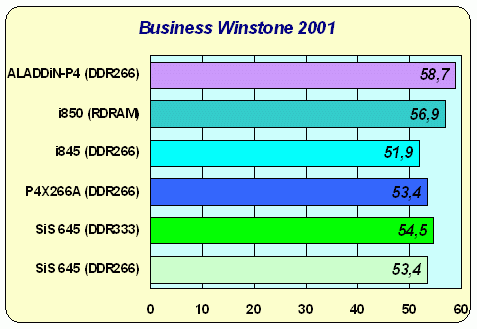
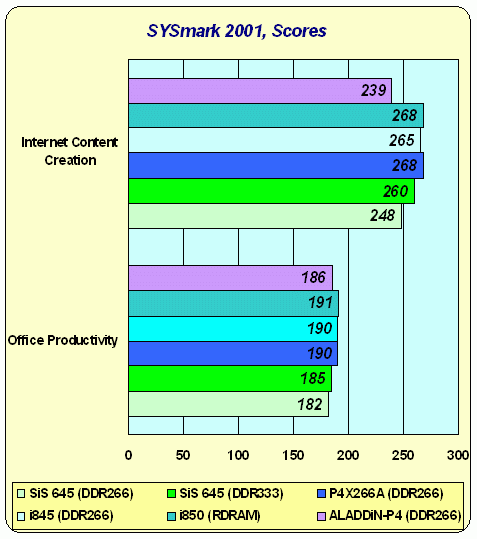
The Business Winstone 2001 probably relate to the first section because its results are rather mysterious: the ALi ALADDiN-P4 was able to beat the others but how? The SYSmark 2001 has more predictable results. The performance level is similar for all competitors, and in the Internet Content Creation we can see two groups again: VIA P4X266 and both Intel's chipsets (one), and SiS 645 and ALi ALADDiN-P4(other). As the ICC is considered to be a memory benchmark provided that processors are the same, the results imply that the SiS and ALi have something wrong with this subsystem. SPEC ViewPerf
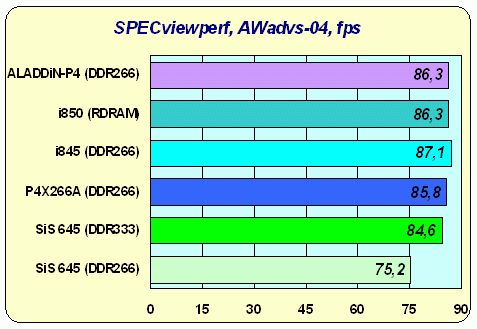
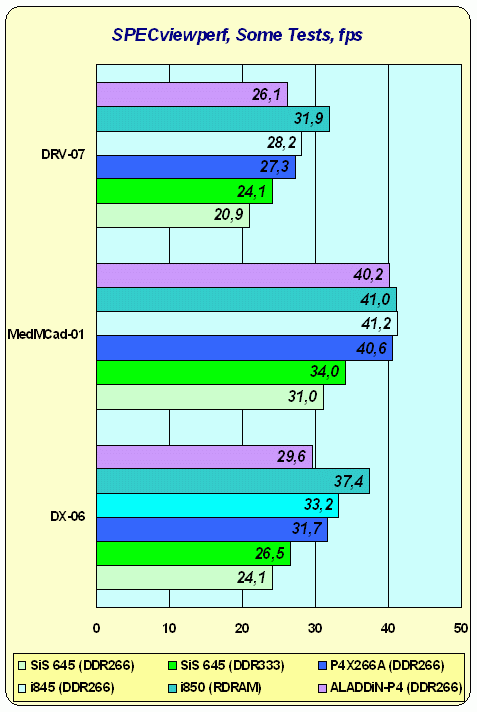
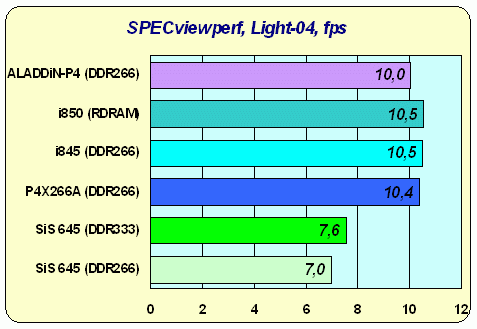
The i850 is galloping ahead; the VIA P4X266A and i845DDR follow it, and the SiS and ALi chipset behave strangely: sometimes they perform on the same level, sometimes the ALADDiN-P4 outscores the other and comes close to the P4X266A. As we found out, these two chipsets operate with the memory at the same speed, that is why it is the GART driver that let down the SiS chipset. And according to the previous tests it always let down chipsets from this company exactly in the SPEC ViewPerf. Encoding and archiving
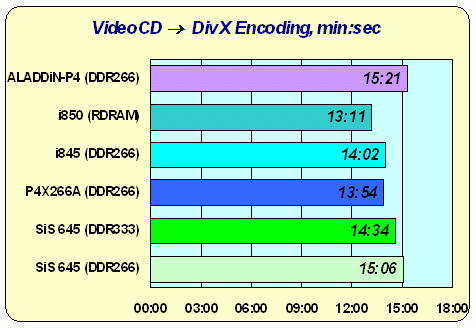
Encoding in the DivX is a good test of operation of RAM in the linear mode, and the results show that the SiS has no problems with its memory controller, while that of the ALADDiN-P4 works rather slowly. In the WinAce the situation is different: the memory load is still great but what matters most of all is latency as a 4 MBytes library means constant searching of fragments inside a relatively large unit. Here the ALi ALADDiN-P4 outscores its traditional competitor. So, the current DDR memory controller of the ALi doesn't implement consecutive reading promptly but it has no problems with latency. ConclusionThe ALi ALADDiN-P4 is, in fact, the same SiS 645, just from another company. Somewhere it works a little slower, somewhere it outscores the other, but on the whole they are on the same level. I hope that when the ALADDiN-P4 gets support of the PC2700 (DDR333), it will be faster than the SiS 645, because in general the latter yields to the former provided that the memory is the same (PC2100/DDR266). Let's look at the issue from the marketing point of view. For the Socket A there is an unquestioned leader - VIA KT266A, and the Pentium 4 is aimed at by a wide range of manufacturers - Intel, VIA Technologies, SiS and ATI (in the near future). Acer Labs was the last to launch its chipset (though it was the first to get the license), and it will hardly help the ALADDiN-P4 much. On the other hand, it supports DDR333 (I hope it will work). It is interesting that all chipsets for the Pentium 4 are very similar, flawless, equal in speed and... faceless, without a zest (except the i850). It is difficult to choose a platform for the Pentium 4 because the processor overshadows its retinue. The specificity of the Pentium 4 + PC2100 DDR system is defined primarily by this processor and just a little by a chipset. Maybe it's asynchronism which is to be blamed (400 MHz processor bus and 266/333 MHz memory) or maybe it's a specific processor core (which became less dependent on a speed of operation with memory when the 256 KBytes L2 cache had been added), but there is no a bright leader for the platform (i850 can't be accounted as the RDRAM is still too expensive). The ALi ALADDiN-P4 is a good choice to assemble an average Pentium 4 + DDR based system on. Besides, Acer Labs will probably soon release a new revision with the improved memory controller. ALi may have a chance to take a certain part of the chipset market from the Pentium 4. It will depend on prices and on convincingness of Acer Labs towards mobo makers. And now I have just to say that the chipset works well, has no bugs and suits excellently an average desktop system. P.S. By the way, since the DDR SDRAM go up in price,
a lot of companies started production of economical boards for the
Pentium 4 which have PC133 slots and are based on the SiS 645. Here
you can take a look at the performance of such system. I just wonder
what the ALADDiN-P4 can offer together with PC133? If it is more
efficient than the SiS 645 + PC133, then taking in account its price
it will get an ideal market niche.
Write a comment below. No registration needed!
|
Platform · Video · Multimedia · Mobile · Other || About us & Privacy policy · Twitter · Facebook Copyright © Byrds Research & Publishing, Ltd., 1997–2011. All rights reserved. |